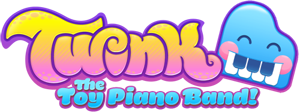Article from Electronic Musician Magazine by Matt Gallagher
Under the guise of Twink, Mike Langlie typically makes music with toy pianos. Langlie describes The Broken Record as his experimental departure that was inspired by Negativland. "It's a tribute to children's music from a time that seems more innocent," he says. The album is a collection of audio collages made up of samples that Langlie extracted from vinyl children's records produced from the 1940s through the 1970s, subtly accompanied by Langlie's programmed parts. "The humor comes from taking songs like 'The Alphabet Song' or 'Pop Goes the Weasel' and sending them in an off-kilter direction," he says.
"Over about a year, I recorded my record collection onto my Mac to make CD mixes," Langlie says. "I used an old Califone schoolhouse record player. It's built like a tank, but it started to conk out after constant use. In some songs you can hear the belt slipping like crazy." Langlie connected the record player's audio output to the audio input on his 1.2 GHz Mac G4 running OS 9 and recorded into Macromedia's SoundEdit 16.
"It took another year to slice up the archived songs using SoundEdit 16 and [Propellerhead] ReCycle," Langlie says. "I organized samples into themes and styles but kept my ears open for unexpected things. The dialog in 'Grandmother Meets the Wolf' was assembled from more than a dozen story records and completely unrelated things.
"I cut up riffs and phrases in ReCycle and then rearranged them in [Propellerhead] Reason," Langlie says. "This allowed me to retain the feel of certain parts while changing the order of notes, keys, or tempos to fit with other pieces, or to simply isolate certain sounds. I sometimes exaggerated the bad pitch-shifting and time-stretching in SoundEdit16, where I thought it would fit with the rough edges of the sampled vinyl." Langlie notes that retaining the original records' pops and skips was essential. "Some of them suggested weird rhythms that I emphasized with my own drum programming, or made interesting polyrhythms when combined with other grainy samples.
"Reason let me manipulate things easily using filters, effects, and EQ," Langlie says. "Having a limitless supply of channels was nice, although I hit the ceiling of what my processor could handle. In those cases, I would export tracks and reimport them as merged stereo samples.
"A lot of songs started with a sampled riff or rhythm loop," Langlie says. "I mostly used Reason's NN19 sampler and Dr.Rex looping modules, tweaking their filters and adding effects. To help parts mesh together, I'd add a subtle bass line underneath the track using Subtractor and Malstrom. I could tweak patches on the fly to add more presence or to get out of the way of other parts as needed. The drum parts are from kiddie records, stuff I found through crate digging, and patterns I programmed using Reason's ReDrum unit. I built kits from drum samples and hits from children's records. I threw in a few toys and cheesy Casio rhythms for flavor."
Tempos and time signatures that changed during the course of a track presented another challenge to Langlie. "For songs that had a lot of sections, like 'Choo Choo' and 'Monkeyshines,' I had to make several Reason files of each tune and then tie them together in SoundEdit16," he says. "For a section in 'Monkeyshines' where the tempo creeps up slightly over several measures, I resorted to exporting the track measure by measure, each time bumping up the tempo a couple notches, then pasting all the pieces together in SoundEdit16. The complexity of it got crazy at times."

